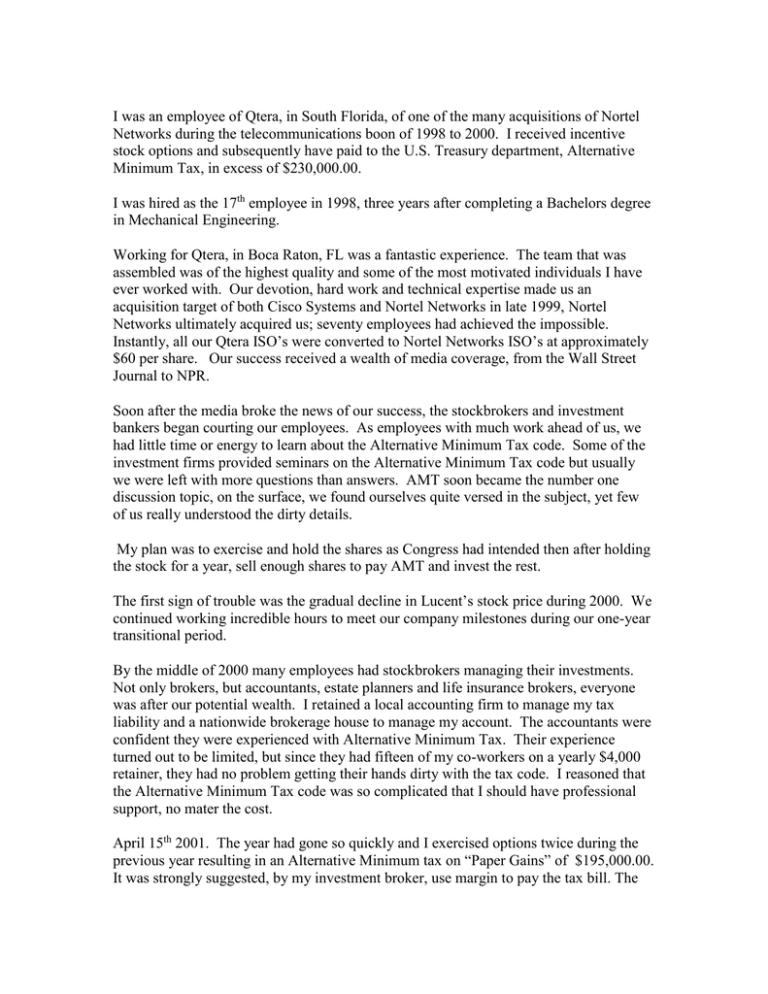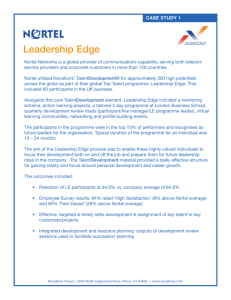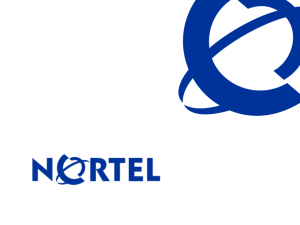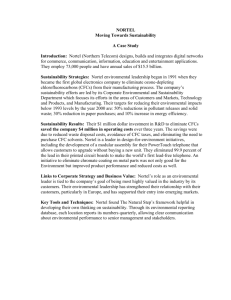I was an employee of Qtera, in South Florida, of... Networks during the telecommunications boon of 1998 to 2000. ...
advertisement

I was an employee of Qtera, in South Florida, of one of the many acquisitions of Nortel Networks during the telecommunications boon of 1998 to 2000. I received incentive stock options and subsequently have paid to the U.S. Treasury department, Alternative Minimum Tax, in excess of $230,000.00. I was hired as the 17th employee in 1998, three years after completing a Bachelors degree in Mechanical Engineering. Working for Qtera, in Boca Raton, FL was a fantastic experience. The team that was assembled was of the highest quality and some of the most motivated individuals I have ever worked with. Our devotion, hard work and technical expertise made us an acquisition target of both Cisco Systems and Nortel Networks in late 1999, Nortel Networks ultimately acquired us; seventy employees had achieved the impossible. Instantly, all our Qtera ISO’s were converted to Nortel Networks ISO’s at approximately $60 per share. Our success received a wealth of media coverage, from the Wall Street Journal to NPR. Soon after the media broke the news of our success, the stockbrokers and investment bankers began courting our employees. As employees with much work ahead of us, we had little time or energy to learn about the Alternative Minimum Tax code. Some of the investment firms provided seminars on the Alternative Minimum Tax code but usually we were left with more questions than answers. AMT soon became the number one discussion topic, on the surface, we found ourselves quite versed in the subject, yet few of us really understood the dirty details. My plan was to exercise and hold the shares as Congress had intended then after holding the stock for a year, sell enough shares to pay AMT and invest the rest. The first sign of trouble was the gradual decline in Lucent’s stock price during 2000. We continued working incredible hours to meet our company milestones during our one-year transitional period. By the middle of 2000 many employees had stockbrokers managing their investments. Not only brokers, but accountants, estate planners and life insurance brokers, everyone was after our potential wealth. I retained a local accounting firm to manage my tax liability and a nationwide brokerage house to manage my account. The accountants were confident they were experienced with Alternative Minimum Tax. Their experience turned out to be limited, but since they had fifteen of my co-workers on a yearly $4,000 retainer, they had no problem getting their hands dirty with the tax code. I reasoned that the Alternative Minimum Tax code was so complicated that I should have professional support, no mater the cost. April 15th 2001. The year had gone so quickly and I exercised options twice during the previous year resulting in an Alternative Minimum tax on “Paper Gains” of $195,000.00. It was strongly suggested, by my investment broker, use margin to pay the tax bill. The margin loan sounded like a reasonable idea, the investment firm provided a low interest loan without liquidating the account, as long as the account value is not less than the loan. Little did I know the bottom was about to drop out. I began to diversify my account, but the majority was still in Nortel stock. Meanwhile, while no one was watching, Nortel Stock fell below $20 per share. The Nortel management was positive on the company’s growth and their overall market position, the low price was a just small correction in the overall market. (We now know these earnings were inflated) By summer of 2001, the margin debt was nerve-racking and I was forced to sell Nortel shares and diversify as the share price continued to slide. I began to exercise and sell, just to raise cash for the 2001 Alternative Minimum Tax. Nothing could stop the hemorrhaging stock price or margin calls. The tax models the accountant had prepared last year were useless. My only concern was having enough cash to pay the AMT and pay off the margin debt. By the end of 2001, we got word that Nortel would soon be downsizing their operations in Florida. Nortel Networks needed to reach the “break even point” and the cutbacks began. By the third quarter of 2001, the share price was under $10 and Nortel was laying off two thirds of their worldwide workforce. April 15th 2002. I had paid estimated tax throughout the year, in hopes of making the April payment manageable and avoiding penalty fees. Each of those quarterly tax payments went on the margin loan. By April 2002, I reached my personal debt limit and liquidated my account to pay off my debt and pay the AMT. The 2001 tax bill was only $37,000.00, a few thousand less than my yearly salary! I ended my contract with my accountant, sold 90% of my investment account, and prepared myself for the possibility that I too would soon lose my job. My fears were realized and by the second quarter of 2002, I was unemployed. I learned many valuable lessons through this experience and I am fortunate that I am not financially ruined like so many of my former colleagues. Many will have their wages garnished, or have filed for personal bankruptcy, some were fortunate enough to negotiate settlements with the IRS. The Alternative Minimum Tax code was implemented to prevent wealthiest 2% of Americans from using special tax benefits to pay little or no tax. For various reasons the Alternative Minimum Tax has reached many hardworking, middle class Americans in South Florida, some who don't have very high incomes or special tax benefits. I hope those in the United States Congress have the compassion and foresight to realize the growing negative effect of the Alternative Minimum Tax and bring change to the outdated tax code. Timothy Masters 1901 South Ocean Blvd. #502 Boca Raton, FL 33432


